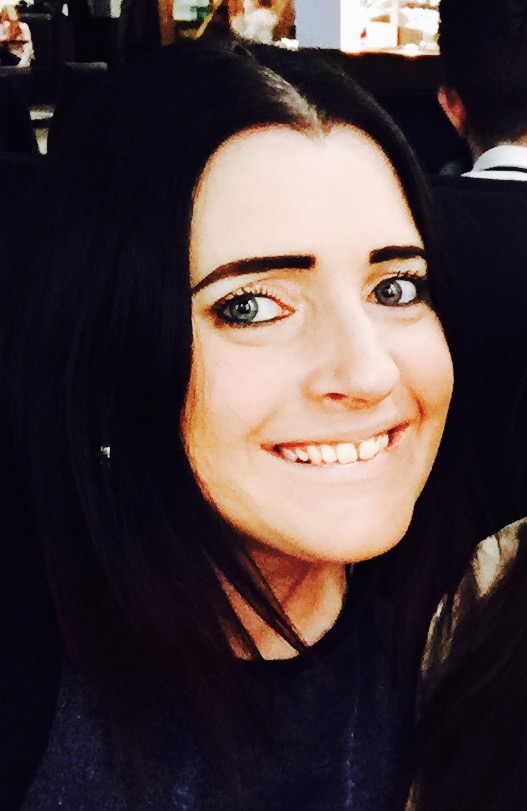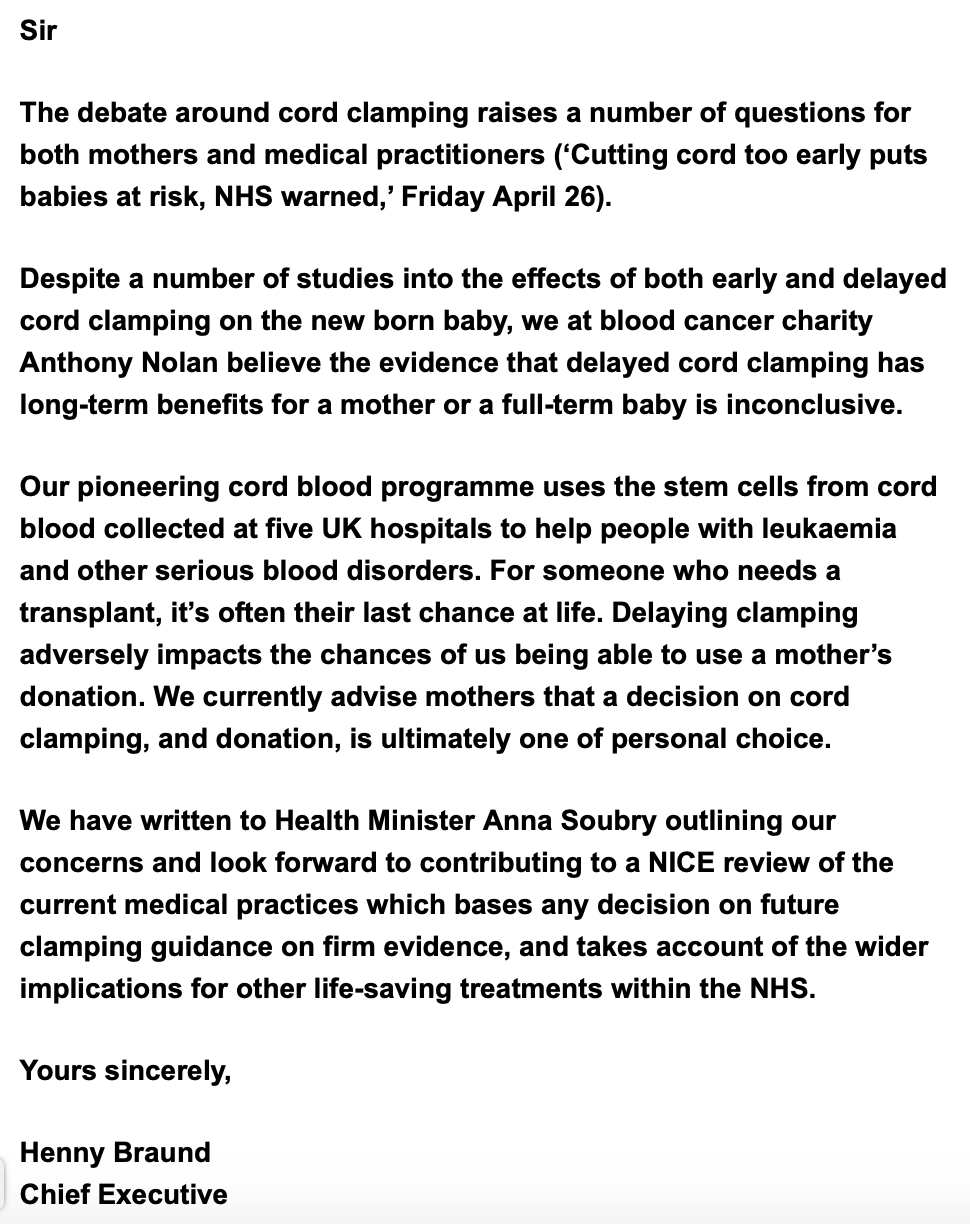Recruiting teens for stem cell collection; back door entry for cord blood donation?
- Hannah Tizard

- Feb 17, 2019
- 4 min read
I was recently contacted by a BloodtoBaby follower on social media who has asked to remain anonymous. For the purposes of this blog I shall call her Sarah. Sarah raised concerns about the recruitment of teenagers to the Antony Nolan stem cell register and the potential influence this may have on young people.
We are concerned that as a consequence these future parents may be more inclined to donate large volumes of their baby's stem cells from blood in the umbilical cord at the birth of their children, without understanding the benefits of delayed and optimal cord clamping to the baby.
Sarah's situation
Sarah informed me that her daughter (age 17) had been contacted by the Antony Nolan Trust who had been allowed to set up a stand and deliver a presentation about stem cell collection at her daughters school. The aim to approach the older students to ask if they are willing to sign up to their stem cell register.
The Organisation
Antony Nolan are a multi faceted charity which uses its register to match potential stem cell donors to blood cancer and blood disorder patients in need of stem cell transplants. Individuals willing to donate their blood stem cells or bone marrow are recruited and their details are held on file and then later potentially matched to a patient in need. The reputable work of the charity improves outcomes and quality of life for people suffering with blood cancer and disorders.
The Hero Project

The very cleverly named education programme that Antony Nolan offers is called 'The Hero Project'. Its aim to teach 16–18-year-olds about the importance of donating stem cells, blood and organs.
Antony Nolan uses celebrity endorsement, captivating and creative marketing to actively target and inspire new individuals to the register, in particular young males who have plentiful stem cells up until age 30.
Why is this relevant to us?
Antony Nolan are also actively trying to raise awareness of their cord blood donation programme which encourages women to donate their baby's blood from the umbilical cord after birth. Although Antony Nolan state they do not get involved with the woman's birth preferences research informs us that delayed and optimal cord clamping dramatically reduces the number and volume of stem cells available for collection (Cuibotariu, 2018). Therefore it is unsurprising that Antony Nolan does not actively educate families about the benefits of delayed and optimal cord clamping to the baby.
Here is an example of Antony Nolan's marketing to mothers considering donating cord blood.
This video in particular is suggestive of the cord being clamped and cut immediately after birth and importantly does not mention the physiological benefits of delayed and optimal cord clamping to the baby.
Back to Sarah's Story
Fortunately Sarah is well educated about the importance of baby receiving its own blood volume, iron count and stem sells at birth and thankfully she swiftly educated her daughter about this. Both Sarah and I believe the ethics of this are troubling, whilst also very complex because we cannot overlook the important work Antony Nolan do to provide stem cell treatments to very sick patients.

That said, is it right to gain access to sensitive minds at this early age? How does this type of marketing impact on possible future decisions to use stem cell donation services? It is clear that early exposure to advertising creates brand awareness and trust which then may lead to acceptance of these procedures without individuals seeking further valuable information later in life. With cord blood donation advertising slogans like "give life twice in one day" and "donating cord blood is risk-free" it's easy to understand why individuals succumb to these types of marketing strategies.
In Sarah's story the school in question is one of the largest 6th form schools in her area, therefore Antony Nolan had access to a substantial number of individuals of reproductive age, potentially gaining their consent and contact information for future stem cell donation. In addition we must consider the young males targeted also having considerable influence on their partners further down the line.
Professional responsibility?
Perhaps these issues could be improved through the provision of balanced evidenced based information from the cord blood donation website?
Having searched the key words 'delayed cord clamping' on the Antony Nolan website, the only direct information I could find was a blog written in 2013 and unfortunately this comes up first in a search.
Make of this what you will but I feel it particularly unethical that Antony Nolan has not provided any further update to this blog post or written any other blog posts about delayed cord clamping particularly since the recommendations made in the 2014 National Institute of Health and Care Excellence guidelines in support of delayed cord clamping.
Balanced information
It is my opinion that all parents should have freedom of choice as to whether they wish to privately bank or donate their baby's stem cells however this must be an informed choice AND new parents must be educated about the vital importance of the physiological benefits of delayed and optimal cord clamping for their baby at birth prior to making any decisions about cord blood banking.
In addition to the plethora of previous evidence about the benefits of delayed cord clamping, newer research by Mercer et al. (2018) concludes that babies born at term (>37 weeks) having delayed cord clamping had greater ferritin levels and increased brain myelin in areas important for functional neurodevelopment which may have long lasting effects.
Equally there is new research evidence regarding stem cell therapies indicating the increasing potential for the use of stem cells with regenerative potential to treat many age related conditions such as diabetes, heart disease and arthritis (Roura et al., 2015). There are many private cord blood banks that are now supporting parents to include delayed and optimal cord clamping whilst also having technologies to facilitate small volumes of residual blood left in the placenta for cord blood banking after delayed cord clamping.
It is not the role of the healthcare professional to decide whether a family should or should not choose cord blood banking but to ensure they are properly informed about both. I have prepared an evidence based leaflet for healthcare professionals about cord blood banking to help aid these discussions.
With regard to cord stem cell donation in this instance it doesn't appear parents are getting informed choice.





